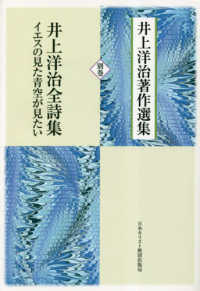- ホーム
- > 洋書
- > 英文書
- > Science / Mathematics
Full Description
Radioastronomy has painted an extraordinary picture of the Galactic interstellar medium, which displays an amazing organization and structuring of matter from very hot ultra-diluted media to very cold denser milieus considered as the cradles of stars. In these latter environments, the discovery of a chemical diversity of molecules, including those associated with precursors to life itself, immediately brought to light the question of the mechanisms leading to their formation and persistence at temperatures as low as 10 K. The chemical networks developed to understand telescope observations required a great deal of physical and chemical parameters relevant to interstellar conditions, particularly at very low temperatures. These included the rate coefficients of thousands of gas phase chemical reactions. Such data were missing in the 1970s, when the very first molecular discoveries were made. Then, in the early eighties, it was realized that uniform supersonic flows were ideal chemical reactors to study reaction kinetics at interstellar temperatures.Uniform Supersonic Flows in Chemical Physics reviews 40 years of use of such reactors, the so-called CRESU machines, focusing on major breakthroughs brought to chemical physics, physical chemistry, astrophysics and astrochemistry by the various experiments carried out with such apparatuses. The wealth of kinetic data at very low temperatures provided new targets for the predictions of theory, with new theoretical methods being developed to explain observed behavior. The first two chapters describe the physical context of reaction kinetics at very low temperatures and the requirements needed to run optimally such uniform supersonic flows, together with a historical perspective. Chapters 3 to 9 describe the various families of chemical processes that have been explored within the CRESU technique, highlighting major advances and offering an exhaustive up-to-date bibliography. Chapters 10 and 11 show how these experimental results have helped in improving the ideas in quantum chemistry and interstellar modeling. The book concludes with an overview of potential perspectives and new routes to be explored.








